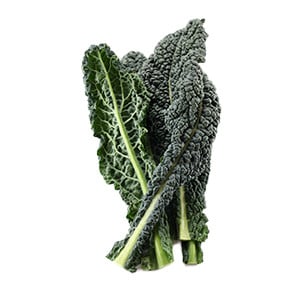Collard greens (Tuscan kale / Dinosaur kale / Palm tree kale)

Collard greens (Tuscan kale / Dinosaur kale / Palm tree kale)
Brassica oleracea var. palmifolia
Plant family
Crucifers (Brassicaceae)
Also known as
Lacinato Kale, Cavolo Nero, Italian Kale, Flat Back Kale, Black Tuscan Palm
Cultivation Break
3 Years
Season Overview
Propagating
Planting
Harvest
Harvest
J
F
M
A
M
J
J
A
S
O
N
D
1ST YEAR
2ND YEAR
Details
Light requirement
Sunny
Water requirement
Moist
Soil
Medium (loamy)
Nutrient requirement
High
Dark germinator
Germination temperature
15 - 20 °C (Degrees Celsius)
Plant distance
50 cm
Row spacing
50 cm
Seeding depth
1.5 cm
Instructions
Beginning of February
Harden
Mid of February
Propagating
Mid of February
Cover
Mid of February
Weeding
Every two Weeks
Mid of February
Transplanting
Mid of February
Planting
Description
Palm cabbage is a variety of vegetable cabbage and belongs to the cruciferous family (Brassicaceae). It is most common in northern Germany, where it is known as the (East) Frisian palm. It owes this name to its growth. The arrangement of the blistered and slightly downward rolled leaves has a palmate appearance. The foliage leaves are dark green to black-green. It can be used in the same way as kale, and its taste is even somewhat finer and milder. However, it is not frost-resistant.
Origin:
Central and Northern Europe, Italy
Growing tips
In the garden, you can grow your palm kale in larger pots or cultivate it entirely in them. This would make the plants mobile in case of frost, which palm kale can only tolerate to a limited extent. In the open, it is best to sow your palm kale after the Ice Saints in May. A place with direct sunlight suits it well. The development time is only about 70 days. Harvest the individual leaves from the bottom up, leaving the top rosette. This gives the palm kale its namesake shape. It also allows the plant to continue growing and reach great heights of up to 3 meters.
Companion Plants
Artichoke
Aubergine / Eggplant
Bean (Broad bean / Faba bean / Field bean)
Bean (Dwarf bean)
Bean (Runner bean)
Beetroot
Black salsify
Borage
Caraway / Meridian fennel / Persian cumin
Carrots
Celery (Celeriac / Celery root)
Celery (Celery)
Chamomile
Chard
Common marigold
Coriander / Cilantro
Cucumber / Gherkin
Dill
Leeks
Lettuce (Endive / Escarole / Erisée)
Lettuce (Lamb's lettuce)
Lettuce (Lettuce)
Lettuce (Radicchio / Italian chicory)
Miner's lettuce / Indian lettuce / Winter purslane
Mint
Oregano
Parsley
Parsnip
Pea
Physalis
Potato
Radish
Radishes
Rhubarb
Sage
Soybean
Spinach (Summer)
Thyme
Antagonistic Plants
Arugula / Rocket
Broccoli
Brussels sprouts
Cabbage (Cabbage)
Cabbage (Savoy cabbage)
Cauliflower
Chives
Collard greens (Kale)
Fennel
Florence fennel / Finocchio
Garlic
Horseradish
Jerusalem artichoke / Topinambur
Kohlrabi / German turnip / Turnip cabbage
Lovage
Marjoram
Mizuna / Japanese mustard greens
Napa cabbage / Chinese cabbage
Okra
Onion
Onion (Spring onion)
Pak Choi
Rutabaga / Swedish turnip
Strawberry
Turnip
Diseases
Root Rot
Club root of cabbage
Early blight of potato
Pests
Flea beetles
Cabbage white
Cabbage fly
White fly